#apsidal basilica
Photo

Today’s Flickr photo with the most hits is an old favourite: the Temple of Zeus at Uzuncaburc, Turkey. It subsequently became an apsidal basilica (Christian), which accounts for its state of preservation, and some of the features of the site.
Close by are a fabulous Hellenistic tower and an ancient mausoleum.
2 notes
·
View notes
Video
Agnus Dei medallion, Basilica di Santa Prassede all’Esquillino, Rome by edk7
Via Flickr:
Apsidal arch mosaic, Byzantine style, c820 en.wikipedia.org/wiki/Santa_Prassede ---- Nikon AF-S Nikkor 70-200mm 1:2.8GII ED SWM VR ED IF _DSC2047 Anx2 Q90 Ap Q11 deskew autosmartfix autosharp crop f25
#Nikon D300#Nikon AF-S Nikkor 70-200mm 1:2.8GII ED SWM VR ED IF#edk7#2010#Italia#Roma#Lazio#Italy#Rome#Basilica di Santa Prassede all#Basilica Sanctae Praxedis#Basilica of Saint Praxedes#church#apse surround#apse arch surround#apsidal arch#mosaic#Christian#Roman Catholic#built c780#rebuilt Pope Paschal I c820#art#artwork#architecture#building#old structure#ancient#late antiquity#arch#vault
1 note
·
View note
Photo

By Travel with Arandjelovic's "Caricin Grad - Justiniana Prima God. 530 - 615 One of the largest and most significant Byzantine cities in the interior of the Balkan is the archeological site from the 6th Century Justinian Prima, the Emperor's city was built 7 km from Lebane, in the South of Serbia. Mounted on gentle slopes descending from Radan Mountain, Caricin town is speed over a 42000 square foot plateau. The city was an important church, adminstration and military center, the seat of the newly established archdiocese - Justinian receives. The city was divided into three parts: Acropolis, Uber and Lower Town. The acropolis was the seat of the church adminstration. A large cathedral church with tree apses, an atrium and a baptistery was discovered there. In the center is the central circular square. And beside them was found a three new basilica with crypt, and then another cruciform basilica with an atrium. The first research began in 1912. The research was finally renewed in 1997, thanks ti Bernard Bavan, and continues today. There is an idea to place the site on the UNESCO World heritage list. ---------- Jedan od najvećih i najznačajnijih vizantijskih gradova u unutrašnjosti Balkana je arheološki lokalitet iz 6 veka Justinijana Prima, Caričin grad je izgrađen na 7km od Lebana, na jugu Srbije. Podignut na blagim padinama koje se spuštaju od planine Radan. Caričin grad se prostire na platou od 42000 kvadratnih metara. Grad je bio važan crkveni, administrativni i vojni centar, sedište novoosnovane arhiepiskopije - Justinijana Prima. Grad je bio podeljen na tri dela: Akropolj, gornji i donji grad. Akropolj je bio sedište crkvene uprave. Tu je otkrivena velika katedralna crkva sa tri apside, atrijumom i krstionicom. U središnjem delu je centralni kružni trg. A pored njih je pronađena i trobrodna bazilika sa kriptom, pa onda još jedna krstoobrazna bazilika sa atrijumom. Prva istraživanja su započeta jos 1912. godine. Opet su konačno obnovljena istraživanja 1997. godine zahvaljujući Bernaru Bavanu i traju i danas. Postoji ideja da se lokalitet upiše u UNESKO listu svetske kulturne baštine."
5 notes
·
View notes
Text
Trip Review: Spoleto
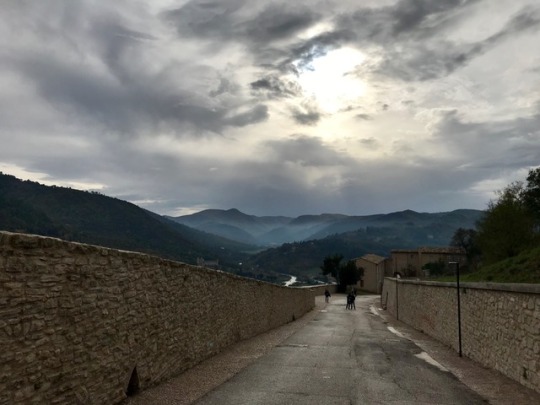
As we are about to start a new semester, we would like to look back for a moment to our last trip. On November 3rd, 2018, the Art History Society went on a very special trip to Spoleto, a wonderful tiny city in Umbria.
Accompanied by Professors Georgi and Smyth, we had the chance to learn about the history of the city, from its Roman foundations to its modern appearance. As the different layers of the city speak of different ages, so do the frescoes in the Basilica of San Gregorio Maggiore, for instance, which date from different epochs, or the ones in the little damaged church of San Pietro e Paolo, which suddenly appears to sight, as it is embedded in the maze of the typical narrow rocky streets of the city.
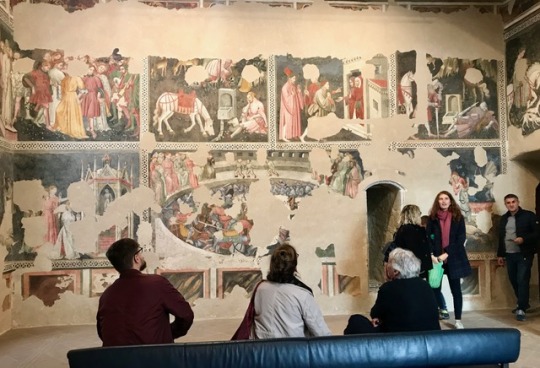
We also visited the exhibition “Trecento Masterpieces,” held in two outstanding locations: part of it was in the Museo Diocesano and in the Basilica of Sant’Eufemia, whereas the second half took place in the Rocca Albornoz on the hilltop of Spoleto. The Basilica of Sant’Eufemia, dating roughly to the first half of the XI century, captivates one’s mind with its bare look and light-colored perfectly-cut bricks. In the coolness of the mid-afternoon air, instead, we made our way up to the Rocca Albornoz, which offered a breathtaking view of the countryside with the sunlight piercing through the clouds. One of the nicest rooms inside the Rocca is the Camera Pinta, a room with early 15th century frescoes which take you back to the elegant chivalric world of knights and ladies, battles and courteous love. On our way back to the train station we stopped at the Cathedral to admire the apsidal frescoes by Fra Filippo Lippi and concluded the day with some delicious local sweets at a pastry shop. We would like to thank all those who came with us and the professors who made that day even more special.
~ by Chiara Traversaro
#jcuarthistorysociety#jcu#WhenRomeIsYourCampus#spoleto#trip#student-run#art#arthistory#art history#fresco#Umbria#italy
1 note
·
View note
Photo


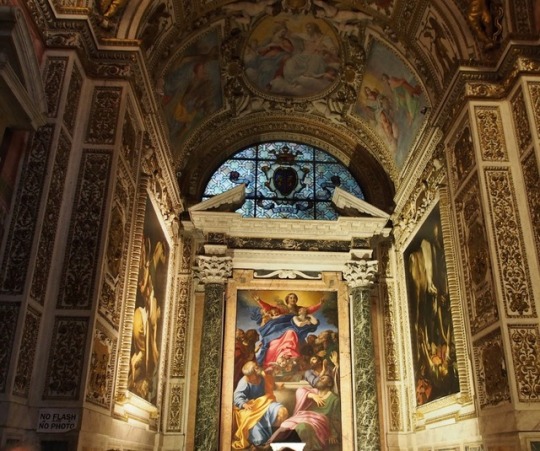

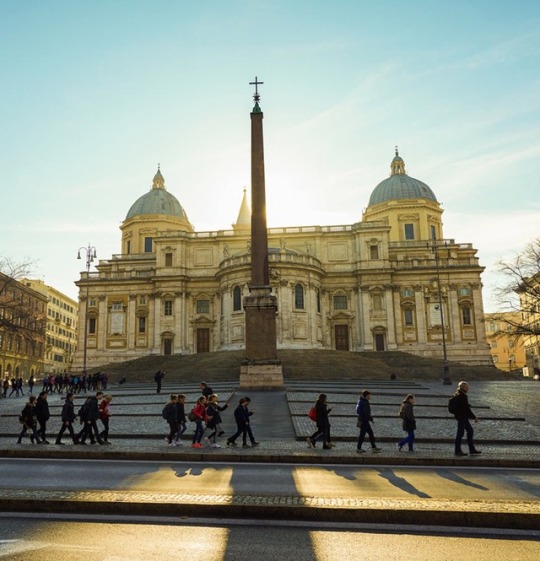
Basilica of Santa Maria del Popolo, Rome In the 16th century Donato Bramante and Rafael Sanzio make new works the apsidal chorus, Raphael, the banker's chapel Agostino Chigi. In the 17th it was Bernini who was in charge of conferring on the temple the current Baroque aspect.
13 notes
·
View notes
Photo

An Explanation of the Gospel Reading For The Second Sunday After Easter - (Latin Calendar) - By An Early Father of The Church - Story 1
Downloadable pamphlet below:
https://docs.wixstatic.com/ugd/a84285_1d5ea45314277cd47127f87a28e61dda.pdf
S e r m o n on The Lamb in Early Christian Symbolism
***
One of the few Christian symbols dating from the first century is that of the Good Shepherd carrying on His shoulders a lamb or a sheep, with two other sheep at his side. Between the first and the fourth century eighty-eight frescoes of this type were depicted in the Roman catacombs.
The signification which may be attached to this symbol, according to Wilpert's interpretation, is as follows. The lamb or sheep on the shoulders of the Good Shepherd is a symbol of the soul of the deceased being borne by Our Lord into heaven; whereas the two sheep accompanying the Shepherd represent the saints already en-joying eternal bliss.
This interpretation is in harmony with an ancient liturgical prayer for the dead of the following tenor: "We pray God . . . to be merciful to him in judgment, having redeemed him by His death, freed him from sin, and reconciled him with the Father. May He be to him the Good Shepherd and carry him on His shoulders [to the fold] May He receive him in the following of the King, and grant him to participate in eternal joy in the Society of the saints" (Muratori, "Lit. Rom. Vet.", I, 751). In catacomb frescoes this petition is represented as already granted; the deceased is in the company of the saints.
Another cycle of catacomb paintings (not numerous) represents a lamb, or a sheep, with a milk-pail either on its back or suspended from a pastoral staff. A unique fresco of this order shows a shepherd milking a sheep, while still another shows milk-pail on an altar between two sheep. The frescoes of this type (of the sheep and milk-pail) were, until recently, generally regarded as symbols of the Eucharist, but Mgr. Wilpert dissents from the received opinion, and regards all frescoes in which allusions to milk occur as symbolic of the joys of Heaven. Both the earlier and the later interpretations depend on a well-known text of the Acts of SS. Perpetua and Felicitas.
While in prison awaiting martyrdom, St. Perpetua tells us she beheld in a vision an immense garden, and in the center thereof the tall and venerable figure of an old man in the dress of a shepherd, milking a sheep. Raising his head, he looked at me and said, 'Welcome, my daughter.' And he called me to him and he gave me of the milk. I received it with joined hands and partook of it. And all those standing around cried ' Amen'. And at the sound of the voice I awoke, tasting an in-describable sweetness in my mouth." The community of ideas between this description and the catacomb frescoes of the sheep and milk-pail is so apparent that, at first view, the current interpretations of this class of representations would seem to be obviously accurate.
Wilpert, however, calls attention to the fact that the things described in the vision of St. Perpetua took place not on earth, but in heaven, where the Eucharist is no longer received . Hence he regards the frescoes of the milk-pail class as symbolic of the joys which the soul of the deceased possess in paradise The lamb, or sheep, symbol, then, of the first class described, has, in all catacomb paintings and on sarcophagi of the fourth century, always a meaning associated with the condition of the deceased after death. But in the new era ushered in by Constantine the Great the lamb appears in the art of the basilicas with an entirely new signification. The general scheme of apsidal mosaic decoration in the basilicas that everywhere sprang into existence after the conversion of Constantine, conformed in the main to that described by St. Paulinus as existing in the Basilica of St. Felix at Nola. "The Trinity gleams in its full mystery", the saint tells us. "Christ is represented in the form of a lamb; the voice of the Father thunders from heaven; and through the dove the Holy Spirit is poured out. The Cross is en-compassed by a circle of light as by a crown.
The crown of this crown are the apostles themselves, who are represented by a choir of doves. The Divine unity of the Trinity is summarized in Christ. The Trinity has at the same time Its own emblems; God is represented by the paternal voice, and by the Spirit; the Cross and the Lamb denote the Holy Victim. The purple background and the palms indicate royalty and triumph. Upon the rock he stands Who is the Rock of the Church, from which flow the four murmuring springs, the Evangelists, living rivers of Christ" (St. Paulinus, "Ep. xxxii, ad Severum", sect. 10, P.L. LXI, 336).
The Divine Lamb was usually represented in apsidal mosaics standing on the mystic mount whence flow the four streams of Paradise symbolizing the Evangelists; twelve sheep six on either side, were further represented, coming from the cities of Jerusalem and Bethlehem (indicated by small houses at the extremities of the scenes) and proceeding towards the lamb.
The lower zone, no longer in existence, of the famous fourth-century mosaic in the church of St. Pudenziana, Rome, originally represented the lamb on the mountain and probably also the twelve sheep; the existing sixth-century apse mosaic of SS. Cosmas and Damian at Rome gives a good idea of the manner in which this subject was represented.
According to the "Liber Pontificalis", Constantine the Great presented to the Lateran baptistery, which he founded, a golden statue of a lamb pouring water which was placed between two silver statues of Christ and St. John the Baptist; the Baptist is represented holding a scroll inscribed with the words: "Ecce Agnus Dei, ecce qui tollit peccata mundi." From the fifth century the head of the lamb began to be encircled by the nimbus. Several monuments also show the lamb with its head surmounted by various forms of the Cross; one monument discovered by de Vogüé in Central Syria shows the lamb with the Cross on its back.
The next step in the development of this idea of associating the Cross with the lamb was depicted in a sixth-century mosaic of the Vatican Basilica which represented the lamb standing on a throne, at the foot of a Cross studded with gems. From the pierced side of this lamb, blood flowed into a chalice whence again it issued in five streams, thus recalling Christ's five wounds.
Finally, another sixth-century monument, now forming part of the ciborium of St. Mark's, Venice, presents a crucifixion scene with the two thieves nailed to the cross, while Christ is represented as a lamb, standing erect at the junction of the crossbeams. One of the most interesting monument showing the Divine Lamb in various characters is the sarcophagus of Junius Bassus (d. 358). In four of the spandrels between the niches of raising Lazarus, by means of a rod, from the tomb; being baptized by another lamb, with dove dominating the scene; multiplying loaves, in two baskets, by the touch of a rod; joining three other lambs.
Two other scenes show a lamb receiving the Tables of the Law on Mount Sinai and striking a rock whence issues a stream of water. Thus in this series, the lamb is a symbol, not only of Christ, but also of Moses, the Baptist, and the Three Children in the fiery furnace. The fresco the cemetery of Praetextatus, showing Susanna as a lamb between two wolves (the elders), is another example of the lamb as symbol of one of the ordinary faithful.
1 note
·
View note
Photo
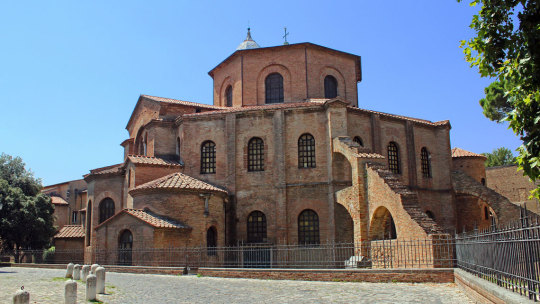

Basilica di San Vitale
La basilica di San vitale a Ravenna fu edificata tra il 540 circa e il 548 nella zona nord-ovest della città.
La basilica combina elementi architettonici romani (la cupola intradosso data, le torri) con elementi bizantini (i capitelli, la costruzione in mattoni).
Dalla forma geometrica del nucleo centrale emergono altri corpi rigorosamente definiti: il tiburio sopraelevato, ottagonale e l’abside, che è poligonale all’esterno e semicircolare all’interno. Di conseguenza, anche il nartece si dispone obliquamente toccando un angolo del perimetro. Nel passaggio fra ingresso e apside, si trovano delle esedra, racchiuse entro grandi archi sostenuti da pilastri angolari, su cui si imposta la cupola.
Celeberrimi, inoltre, Sono i mosaici raffiguranti il corteo dell’imperatore Giustiniano e della moglie Teodora. La decorazione dello sfondo era in oro ed evidenziava uno spazio ultraterreno. Le figure sono ritratte frontalmente, secondo una rigida gerarchia di corte, con al centro gli Augusti. Giustiniano porta sulle mani una patena d’oro.
0 notes
Photo



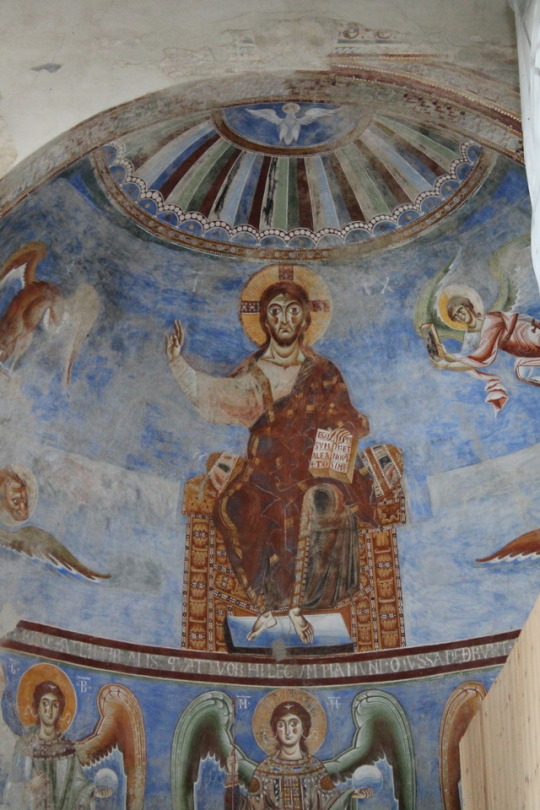

New Writer Favorite Artwork Fact File
To welcome our new IASblog writers, we thought it would be wonderful if they introduce themselves by sharing their favorite work as one of our “Favorite Artwork Fact Files (FAFF). Our fourth and final FAFF comes from Rachel Hiser Remmes.
What is your favorite artwork? The eleventh-century fresco program in the Basilica of Sant’Angelo in Formis in Capua, Italy, undertaken circa 1072-85/7.
...and your favorite detail? My favorite detail is the donor portrait of Abbot Desiderius in the lower register of the apse on the left-hand side. He holds a model of the church of Sant’Angelo and is curiously dressed in non-abbatial garb.
Why? My Master’s thesis focused on the reception of the fresco program during the church’s dedication ritual. Curiously enough, my visit to the space affirmed my contention that the receptive import of the frescoes cannot be experienced properly except when viewed from within the space. Even though I had spent time researching Sant’Angelo in Formis before my trip, when I stepped into the church it was as if I was seeing it for the first time. Details emerged that I had never noticed, and it was these details that prompted my thesis.
IASblog (Rachel) explains...
Originally a pagan temple dedicated to Diana, the current structure at Sant’Angelo underwent several major renovations in the early Christian and medieval eras. It is tucked away on Mount Tifata in the town of Capua.
The fresco program in Sant’Angelo is one of the earliest fresco programs preserved in-situ, of which a majority is still intact. Most of the program that is visible today is from the eleventh-century campaign initiated by Abbot Desiderius of Montecassino in 1072, shortly after he finished the famous Basilica of St. Benedict’s at Montecassino. The program has gained some of its fame because of its temporal and patronal relationship to St. Benedict’s Basilica, which was devastated by an earthquake in the fourteenth century and then completely demolished in bombings during World War II. Many scholars believe Sant’Angelo to be a near identical replica of the grander Basilica of St. Benedict’s, but this is still open for debate. Regardless, Sant’Angelo preserves the architectural and spatial thought of Abbot Desiderius more fully than any other extant building.
Furthermore, the patron portrait of Abbot Desiderius himself has also initiated interest. Unlike many of the earlier patron portraits found within apsidal spaces in Rome, usually within the conch of the apse, as at SS. Cosmos and Damien, Santa Cecilia in Trastevere, Santa Prassede, Abbot Desiderius is placed in the lower register at the edge of the apse and closest to the nave. Furthermore, an intercessor saint does not present him to Christ in Majesty, a common medieval iconography. His lavish dress and life-like size only enhance his prestige and intrigue as a historical figure and artistic patron.
Additionally, the church is unique because it diverges from the more typical organization of nave imagery. Unlike the nave of Old St. Peter’s or the Basilica of St. Benedict’s, both of which display both Old and New Testament imagery in the nave, Sant’Angelo’s nave is covered with New Testament scenes, while those from the Old Testament decorate the two side aisles. Unique themes emerge within the New Testament program, including the focus on the parables and an unprecedented image of St. John the Baptist.
References
Cowdery, H.E.J. The Age of Abbot Desiderius: Montecassino, the Papacy, the
Normans in the Eleventh and Twelfth Centuries. Oxford: Clarendon Press, 1983.
Gunhouse, Glenn. “The Fresco Decoration of Sant’Angelo in Formis.” Dissertation, John Hopkins University, 1991.
Kessler, Herbert L. Old St. Peter’s and Church Decoration in Medieval Italy. Spoleto:Centro Italiano di studi sull’alto Medioevo, 2002.
Lipsmeyer, Elizabeth. “The Donor and His Church Model In Medieval Art form Early Christian to the Late Romanesque Period.” Dissertation, Rutgers University, 1981.
Minott, Charles. “The Iconography of the Life of Christ in the Church of Sant’Angelo.” Dissertation, Princeton University, 1967.
Thunø, Erik. The Apse Mosaic in Early Medieval Rome, Time, Network, and Repetition. New York, NY: Cambridge University Press, 2015.
Main façade of the Basilica of Sant’Angelo in Formis, Capua.
Various views of the interior fresco program, including a view of Abbot Desiderius and Christ Pantoktrator in the main apse, Basilica of Sant’Angelo in Formis, Capua. Images courtesy of the author.
#rachel hiser remmes#iasblog#capua#sant'angelo#basilica#abbot desiderius#11th century#fresco#medieval#art history#faff
29 notes
·
View notes
Text
Píše sa rok 64 a Rím sa zmieta v plameňoch rozsiahleho požiaru, ktorý zničil takmer tri štvrtiny mesta. Z jeho založenia sú obvinení kresťania, a tak cisár Nero začína jednu z najrozsiahlejších razií proti vyznávačom tejto viery. Mnohí z nich, v obavách pred istou smrťou na popravisku, hľadajú spásu v úteku a masovo opúšťajú mesto. Medzi nimi je aj apoštol Peter, najvernejší a najobľúbenejší z Kristových učeníkov. Podľa legendy sa mu však počas cesty na Via Appia zázračne zjaví Ježiš a v odpovedi na otázku “Domine, quo vadis?” ho prinúti k návratu späť do Ríma, aby tu podstúpil mučenícku smrť. Krátko na to je Peter ukrižovaný na úpätí vatikánskeho pahorku v miestach, kde sa dnes rozprestiera známe námestie sv. Petra.
Zmučené telo ešte tej istej noci pochovali Petrovi nasledovníci pri stene, neďaleko popravisko. Tak je aspoň príbeh apoštola zaznamenaný v cirkevných knihách. Pravosť miesta jeho posledného odpočinku však bola po mnohé storočia spochybňovaná. Preto je až prekvapujúce, že archeologické práce tu začali iba v 30. rokoch minulého storočia. Nález starého rímskeho pohrebiska a kostrových pozostatkov v oddelenom hrobe, ktorého poloha aj popis sa s rozprávaním zhodovali, však pôvodnú verziu aspoň čiastočne potvrdili. V roku 1968 pápež Pavol IV oficiálne vyhlasuje, že nájdené pozostatky skutočne patria tomuto významnému svätcovi.
Trocha histórie neuškodí
O necelé tri stáročia po Petrovom ukrižovaní vyrástla na príkaz pápeža Silvestra I. Konštantína Veľkého v miestach jeho hrobu bazilika. Pôvodná päťpodlažná budova sa čoskoro stala nielen dôležitým pútnickým miestom pre kresťanov, ale pod jej strechou sa konali všetky dôležité cirkevné obrady. V roku 800 tu prijal z rúk pápeža Leva III. cisársku korunu aj sám Karol Veľký. Avšak ani tejto majestátnej a bohato zdobenej stavbe sa nevyhol zub času, a tak z nej v 15. storočí ostávajú už len obyčajné ruiny. Až pápež Július II. našiel odvahu a aj napriek veľkým protestom veriacich sa rozhodol zvyšky starej baziliky strhnúť. Na mieste pôvodnej baziliky nechal postaviť úplne novú katedrálu, ktorá dominuje námestiu sv. Petra dodnes. Stavba bola začatá v roku 1506 a pretiahla sa na dlhých 120 rokov. Podieľali sa na nej najvýznamnejší umelci svojej doby, medzi nimi aj Raphael, B. Peruzzi, Antonio da Sangallo či Michelangelo. A tak nie je divu, že katedrála sv. Petra je dodnes pýchou Vatikánu. Vďaka svojej výške, dosahujúcou 120 metrov, je vôbec najväčšou cirkevnou stavbou na svete a pojme na 60 tisíc veriacich.
Poklady ukryté v bazilike
Ešte než vstúpime dovnútra chrámu, uchváti nás pohľad na monumentálne priečelie, v ktorého hornej časti sú umiestnené šesťmetrové sochy svätcov. Priamo nad hlavný vchod bola tiež situovaná loggia, z ktorej dodnes udeľuje pápež pri významných kresťanských sviatkoch požehnanie celému mestu a svetu. Podobne pôsobivý je ale aj interiér baziliky, ktorý zdobí celý rad vzácnych diel. Medzi nimi vyniká nezabudnuteľná Michelangelova Pieta. Táto mramorová socha, zachytávajúca Máriu s Ježišom, sňatým z kríža, je unikátny nielen svojou krásou a jemnými črtami, zdôrazňujúcimi žiaľ matky nad mŕtvym synom, ale tiež tým, že sa jedná o jediné dielo na svete, ktoré Michelangelo autorsky podpísal.
Pri pozornejšom pohľade si môžeme všimnúť na šerpe, zdobiacej Máriino poprsie, nápis “Toto zhotovil Michelangelo Buonarroti Florentský”. Pôvodne mala byť Pieta ozdobou hrobu francúzskeho kardinála Jeana de Billhera, na svoje dnešné miesto bola prenesená až o storočie neskôr. Počas presunu bola bohužiaľ čiastočne zničená. Oveľa väčšiu skazu však pre tento klenot svetového sochárstva predstavovala návšteva pomäteného jedinca (Laszlo Toth), ktorý v roku 1973 sochu vážne poškodil sekerou. Od tej doby je Pieta vystavovaná iba za nerozbitným sklom.
Aj z dielne ďalšieho veľkého umelca, vo svojej dobe veľmi uznávaného Antonia Canovu, pochádza niekoľko zaujímavých diel. Medzi nimi aj pomník kráľovskej rodiny Stuartovcov, či pápeža Klementa XIII. Za pozornosť však stojí aj socha sv. Petra na tróne, ktorú v 13. storočí vytvoril Arnolfo di Cambio. Práve k nej po celé stáročia mieria pútnici, aby svojim letmým bozkom priehlavku Petrovej nohy, vyjadrili úctu tomuto veľkému svätcovi.
Ústredným bodom baziliky je pápežský oltár, stojaci nad údajným hrobom sv. Petra. Spoznáme ho podľa tridsať metrov vysokého bronzového baldachýnu, ktorá predstavuje majstrovskú prácu zo 17. storočia. Jej autorom je Bernini, umelec s ktorého dielami sa v priestoroch baziliky stretneme asi najčastejšie. V apside za ním stojí trón sv. Petra, na ktorom sedával apoštol v čase svojho pobytu v Ríme. V susedstve hlavného oltára je tiež vstup do podzemia, kde je umiestnených vyše sto hrobiek pápežov, vrátane Jána Pavla II., a niekoľkých členov kráľovskej rodiny Stuartovcov.
Bazilika sv. Petra je otvorená celoročne. Vstupné sa platí len na kupolu, odkiaľ je nádherný výhľad na námestie. Ak sa vám nechce absolvovať 323 schodov pešo, môžete sa za príplatok nechať vyviezť výťahom. V celom objekte je od návštevníkov striktne vyžadované vhodné oblečenie zakrývajúce ramená.
Fotogaléria:
interior St. Peter’s Basilica in Vatican
Čo by ste mali vidieť: Bazilika sv. Petra vo Vatikáne Píše sa rok 64 a Rím sa zmieta v plameňoch rozsiahleho požiaru, ktorý zničil takmer tri štvrtiny mesta.
0 notes
Photo

Apse
This article is about the architectural feature. For the astronomical term, see apsis. For the rock band, see Apse (band). For the acronym APS, see APS (disambiguation). Typical early Christian Byzantine apse with a hemispherical semi-dome in the Basilica of Sant'Apollinare in Classe. Typical floor plan of a cathedral. Apse is shown in beige In architecture, an apse (from Latin absis: "arch, vault" from Greek ἀψίς apsis "arch"; sometimes written apsis; plural apsides) is a semicircular recess covered with a hemispherical vault or semi-dome, also known as an Exedra. In Byzantine, Romanesque, and Gothic Christian church (including cathedral and abbey) architecture, the term is applied to a semi-circular or polygonal termination of the main building at the liturgical east end (where the altar is), regardless of the shape of the roof, which may be flat, sloping, domed, or hemispherical. Smaller apses may also be in other locations, especially shrines.
More details Android, Windows
0 notes
Text
Vespers
One of mine - an excerpt from Rome Vignettes I wrote when I visited the city for the first time.
Vespers:
The Basilica of St Paul Outside the Walls is ancient: 3rd CE. It has been much modified yet it still retains the essential aspects of a properly Roman basilica – an apsidal space with an impressive four aisles, and transepts.
It is fronted by a portico’d garden and has adjacent cloisters for the monks who originally resided here.
As a space, I found it awesome: more affecting even than St Peter’s. Perhaps the timing was instrumental –
I went in the late evening: there were very few people inside, the lighting was subdued, the interior mosaics hinted at glory, the cavernous, architecturally austere and regular space dwarfed me. As I drank in the details, there were signs that something was afoot but I was more concerned to descend the well that sits immediately in front of the baldachin’d Papal altar, and see Paul’s tomb. His sarcophagus sits, visible, behind a window’d recess.
As I returned to the nave, and looked past the great baldachino, I could see lights ablaze in the apse. A file of Benedictine monks had assembled for evening prayer, One of their number was seated at a little pipe organ to underpin the plainsong. The rest of the basilica was dark. The columns in the nave were casting strong shadows. The alabaster windows were opaque and dull, save in the west. The space was subdued. The atmosphere was compelling.
We were few in number – maybe a dozen monks and a dozen of us. The liturgy was a sung Vespers in the vernacular, with two young cantors to lead the responses. It was odd, being there. Twenty-two years since I left the friars. Any sort of a service is a bit disconcerting for an atheist, more so when it reaches into places at once familiar and distant. Vespers, in a papal basilica, atop the tomb of St Paul, with Benedictine monks, scores kind of highly on the things to discombobulate Damian scale. But, essentially, it was alright. It’s not my stuff anymore but I’m alert to life’s complexities, to my own complexities, and human aspirations are not inaccessible to atheists! Sung vespers vocalises that as effectively as anything else might. Vespers doesn’t change its format of introit, hymn, psalms, readings, magnificat, intercessions, pater noster and dismissal. I could follow things happily enough and join in some responses. I even remembered the pater noster – words and melody. For 40 minutes, I was simultaneously disconcerted, soothed, elevated and affirmed.
When I left the basilica it was properly dark. Too late to access the portico and cloister, too dark to get any properly good photos of the exterior. But there was a still, small light I took away with me.
I couldn’t have planned, intended or effected a better, more serendipitous, way to pass my last evening in the city.
#rome#st paul outside the walls#basilica#vespers#evening prayer#pilgrim#visit#prayer#damian's writings
1 note
·
View note
Photo

Duomo di Cafalù (dalla Rocca) by raffaele pagani UNESCO World Heritage Site (2015) Cathedral of Cefalù (Basilica Cathedral of the Transfiguration) Consecration: 1267 architectural style: Byzantine, Arabic-Norman Groundbreaking: 1131 Completed: 1148 (apsidal mosaics), 1240 (facade), 1263 (cover), 1471 (porch) http://flic.kr/p/WmLq3p
0 notes
Text
Vespers
One of mine - after a visit to St Paul's Outside the Walls
Vespers:
The Basilica of St Paul Outside the Walls is ancient: 3rd CE. It has been much modified yet it still retains the essential aspects of a properly Roman basilica – an apsidal space with an impressive four aisles, and transepts.
It is fronted by a porticoed garden and has adjacent cloisters for the monks who originally resided here.
As a space, I found it awesome: more affecting even than St Peter’s. Perhaps the timing was instrumental –
I went in the late evening: there were very few people inside, the lighting was subdued, the interior mosaics hinted at glory, the cavernous, architecturally austere and regular space dwarfed me. As I drank in the details, there were signs that something was afoot but I was more concerned to descend the well that sits immediately in front of the baldacchin'd Papal altar, and see Paul’s tomb. His sarcophagus sits, visible, behind a windowed recess.
As I returned to the nave, and looked past the great baldacchino, I could see lights ablaze in the apse. A file of Benedictine monks had assembled for evening prayer, One of their number was seated at a little pipe organ to underpin the plainsong. The rest of the basilica was dark. The columns in the nave were casting strong shadows. The alabaster windows were opaque and dull, save in the west. The space was subdued. The atmosphere was compelling.
We were few in number – maybe a dozen monks and a dozen of us. The liturgy was a sung Vespers in the vernacular, with two young cantors to lead the responses. It was odd, being there. Twenty-two years since I left the friars. Any sort of a service is a bit disconcerting for an atheist, more so when it reaches into places at once familiar and distant. Vespers, in a papal basilica, atop the tomb of St Paul, with Benedictine monks, scores kind of highly on the things to discombobulate Damian scale. But, essentially, it was alright. It’s not my stuff anymore but I’m alert to life’s complexities, to my own complexities, and human aspirations are not inaccessible to atheists! Sung vespers vocalises that as effectively as anything else might. Vespers doesn’t change its format of introit, hymn, psalms, readings, magnificat, intercessions, pater noster and dismissal. I could follow things happily enough and join in some responses. I even remembered the pater noster – words and melody. For 40 minutes, I was simultaneously disconcerted, soothed, elevated and affirmed.
When I left the basilica it was properly dark. Too late to access the portico and cloister, too dark to get any properly good photos of the exterior. But there was a still, small light I took away with me.
I couldn’t have planned, intended or effected a better, more serendipitous, way to pass my last evening in the city.
Amen to that.
#vespers#st paul outside the walls#basilica#rome#prayer#plainsong#evening prayer#holiday#roman catholic#atheist#damian's writing
1 note
·
View note
Photo
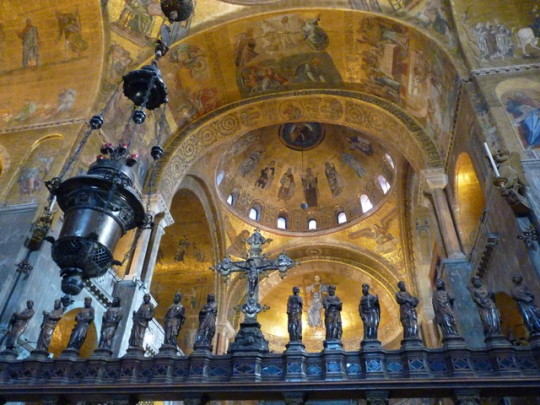
Today’s Flickr photo - an interior shot in the Basilica San Marco, Venice - the dome and apsidal semi-dome from the sanctuary screen.
0 notes
